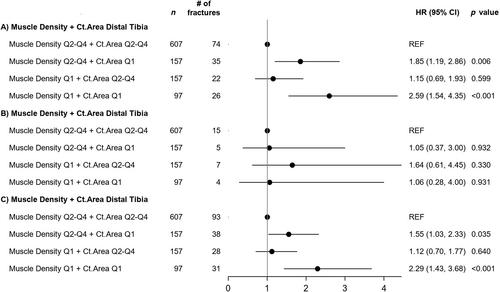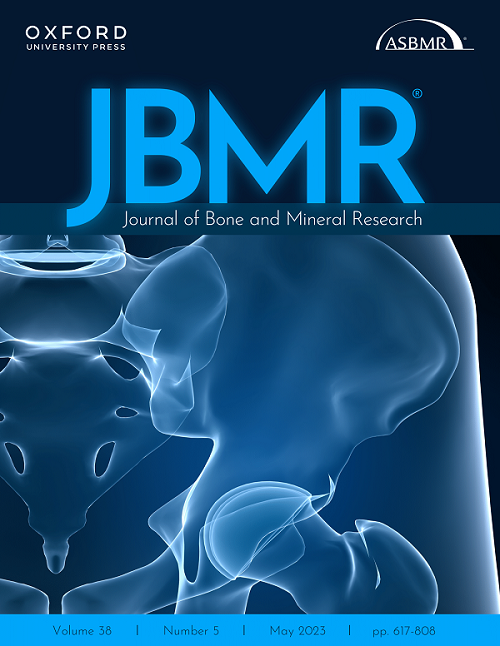Ben Kirk, Stephanie L Harrison, Jesse Zanker, Andrew J Burghardt, Eric Orwoll, Gustavo Duque, Peggy M Cawthon
下载PDF
{"title":"HR-pQCT骨密度和D3Cr肌肉质量(或HR-pQCT-Bone Structure和HR-pQCT-Muscle Density)在预测骨折中的相互作用:男性骨质疏松性骨折研究","authors":"Ben Kirk, Stephanie L Harrison, Jesse Zanker, Andrew J Burghardt, Eric Orwoll, Gustavo Duque, Peggy M Cawthon","doi":"10.1002/jbmr.4874","DOIUrl":null,"url":null,"abstract":"<p>We examined if an interaction exists between bone and muscle in predicting fractures in older men. Prospective data from the Osteoporotic Fractures in Men study was used to build Cox proportional hazards models. Predictors included HR-pQCT total volumetric BMD (Tt.BMD), trabecular BMD (Tb.BMD), cortical BMD (Ct.BMD) and cortical area (Ct.Ar) at distal radius/tibia, HR-pQCT muscle volume and density (diaphyseal tibia), D<sub>3</sub>-creatine dilution (D<sub>3</sub>Cr) muscle mass, and grip strength and leg force, analyzed as continuous variables and as quartiles. Incident fractures were self-reported every 4 months via questionnaires and centrally adjudicated by physician review of radiology reports. Potential confounders (demographics, comorbidities, lifestyle factors, etc.) were considered. A total of 1353 men (mean age 84.2 ± 4.0 years, 92.7% white) were followed for 6.03 ± 2.11 years. In the unadjusted (continuous) model, there were no interactions (<i>p</i> > 0.05) between any muscle variable (D<sub>3</sub>Cr muscle mass, muscle volume, muscle density, grip strength or leg force) and Tt.BMD at distal radius/tibia for fractures (all: <i>n</i> = 182–302; nonvertebral: <i>n</i> = 149–254; vertebral: <i>n</i> = 27–45). No consistent interactions were observed when interchanging Tt.BMD for Tb.BMD/Ct.BMD or for Ct.Ar (bone structure) at the distal radius/tibia in the unadjusted (continuous) models. Compared with men in quartiles (Q) 2–4 of D<sub>3</sub>Cr muscle mass and Q2–4 of distal tibia Tt.BMD, men in Q1 of both had increased risk for all fractures (hazard ratio (HR) = 2.00; 95% confidence interval [CI] 1.24–3.23, <i>p</i> = 0.005) and nonvertebral fractures (HR = 2.10; 95% CI 1.25–3.52, <i>p</i> < 0.001) in the multivariable-adjusted model. Confidence intervals overlapped (<i>p</i> > 0.05) when visually inspecting other quartile groups in the multivariable-adjusted model. In this prospective cohort study of older men, there was no consistent interactions between bone and muscle variables on fracture risk. Larger sample sizes and longer follow-up may be needed to clarify if there is an interaction between bone and muscle on fracture risk in men. © 2023 The Authors. <i>Journal of Bone and Mineral Research</i> published by Wiley Periodicals LLC on behalf of American Society for Bone and Mineral Research (ASBMR).</p>","PeriodicalId":185,"journal":{"name":"Journal of Bone and Mineral Research","volume":"38 9","pages":"1245-1257"},"PeriodicalIF":5.9000,"publicationDate":"2023-06-23","publicationTypes":"Journal Article","fieldsOfStudy":null,"isOpenAccess":false,"openAccessPdf":"https://onlinelibrary.wiley.com/doi/epdf/10.1002/jbmr.4874","citationCount":"0","resultStr":"{\"title\":\"Interactions Between HR-pQCT Bone Density and D3Cr Muscle Mass (or HR-pQCT Bone Structure and HR-pQCT Muscle Density) in Predicting Fractures: The Osteoporotic Fractures in Men Study\",\"authors\":\"Ben Kirk, Stephanie L Harrison, Jesse Zanker, Andrew J Burghardt, Eric Orwoll, Gustavo Duque, Peggy M Cawthon\",\"doi\":\"10.1002/jbmr.4874\",\"DOIUrl\":null,\"url\":null,\"abstract\":\"<p>We examined if an interaction exists between bone and muscle in predicting fractures in older men. Prospective data from the Osteoporotic Fractures in Men study was used to build Cox proportional hazards models. Predictors included HR-pQCT total volumetric BMD (Tt.BMD), trabecular BMD (Tb.BMD), cortical BMD (Ct.BMD) and cortical area (Ct.Ar) at distal radius/tibia, HR-pQCT muscle volume and density (diaphyseal tibia), D<sub>3</sub>-creatine dilution (D<sub>3</sub>Cr) muscle mass, and grip strength and leg force, analyzed as continuous variables and as quartiles. Incident fractures were self-reported every 4 months via questionnaires and centrally adjudicated by physician review of radiology reports. Potential confounders (demographics, comorbidities, lifestyle factors, etc.) were considered. A total of 1353 men (mean age 84.2 ± 4.0 years, 92.7% white) were followed for 6.03 ± 2.11 years. In the unadjusted (continuous) model, there were no interactions (<i>p</i> > 0.05) between any muscle variable (D<sub>3</sub>Cr muscle mass, muscle volume, muscle density, grip strength or leg force) and Tt.BMD at distal radius/tibia for fractures (all: <i>n</i> = 182–302; nonvertebral: <i>n</i> = 149–254; vertebral: <i>n</i> = 27–45). No consistent interactions were observed when interchanging Tt.BMD for Tb.BMD/Ct.BMD or for Ct.Ar (bone structure) at the distal radius/tibia in the unadjusted (continuous) models. Compared with men in quartiles (Q) 2–4 of D<sub>3</sub>Cr muscle mass and Q2–4 of distal tibia Tt.BMD, men in Q1 of both had increased risk for all fractures (hazard ratio (HR) = 2.00; 95% confidence interval [CI] 1.24–3.23, <i>p</i> = 0.005) and nonvertebral fractures (HR = 2.10; 95% CI 1.25–3.52, <i>p</i> < 0.001) in the multivariable-adjusted model. Confidence intervals overlapped (<i>p</i> > 0.05) when visually inspecting other quartile groups in the multivariable-adjusted model. In this prospective cohort study of older men, there was no consistent interactions between bone and muscle variables on fracture risk. Larger sample sizes and longer follow-up may be needed to clarify if there is an interaction between bone and muscle on fracture risk in men. © 2023 The Authors. <i>Journal of Bone and Mineral Research</i> published by Wiley Periodicals LLC on behalf of American Society for Bone and Mineral Research (ASBMR).</p>\",\"PeriodicalId\":185,\"journal\":{\"name\":\"Journal of Bone and Mineral Research\",\"volume\":\"38 9\",\"pages\":\"1245-1257\"},\"PeriodicalIF\":5.9000,\"publicationDate\":\"2023-06-23\",\"publicationTypes\":\"Journal Article\",\"fieldsOfStudy\":null,\"isOpenAccess\":false,\"openAccessPdf\":\"https://onlinelibrary.wiley.com/doi/epdf/10.1002/jbmr.4874\",\"citationCount\":\"0\",\"resultStr\":null,\"platform\":\"Semanticscholar\",\"paperid\":null,\"PeriodicalName\":\"Journal of Bone and Mineral Research\",\"FirstCategoryId\":\"3\",\"ListUrlMain\":\"https://onlinelibrary.wiley.com/doi/10.1002/jbmr.4874\",\"RegionNum\":1,\"RegionCategory\":\"医学\",\"ArticlePicture\":[],\"TitleCN\":null,\"AbstractTextCN\":null,\"PMCID\":null,\"EPubDate\":\"\",\"PubModel\":\"\",\"JCR\":\"Q1\",\"JCRName\":\"ENDOCRINOLOGY & METABOLISM\",\"Score\":null,\"Total\":0}","platform":"Semanticscholar","paperid":null,"PeriodicalName":"Journal of Bone and Mineral Research","FirstCategoryId":"3","ListUrlMain":"https://onlinelibrary.wiley.com/doi/10.1002/jbmr.4874","RegionNum":1,"RegionCategory":"医学","ArticlePicture":[],"TitleCN":null,"AbstractTextCN":null,"PMCID":null,"EPubDate":"","PubModel":"","JCR":"Q1","JCRName":"ENDOCRINOLOGY & METABOLISM","Score":null,"Total":0}
引用次数: 0
引用
批量引用


 求助内容:
求助内容: 应助结果提醒方式:
应助结果提醒方式:


